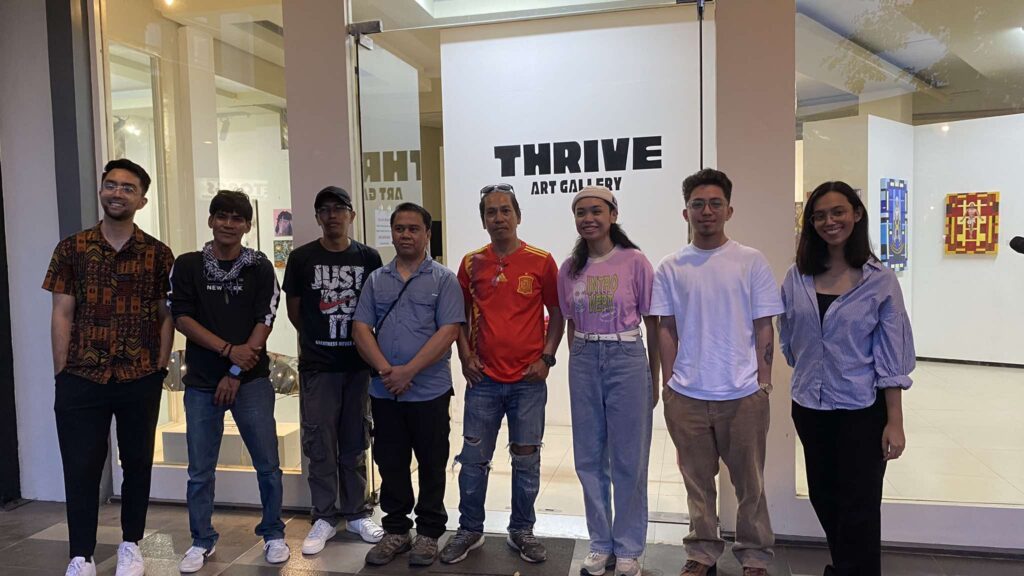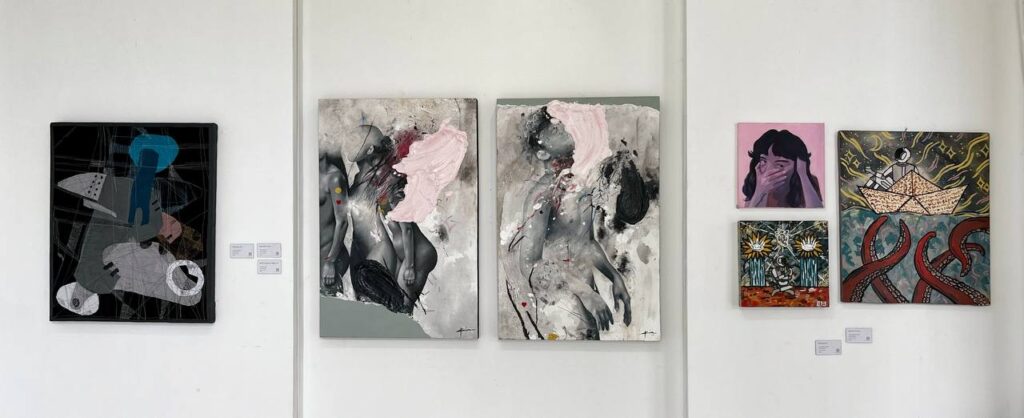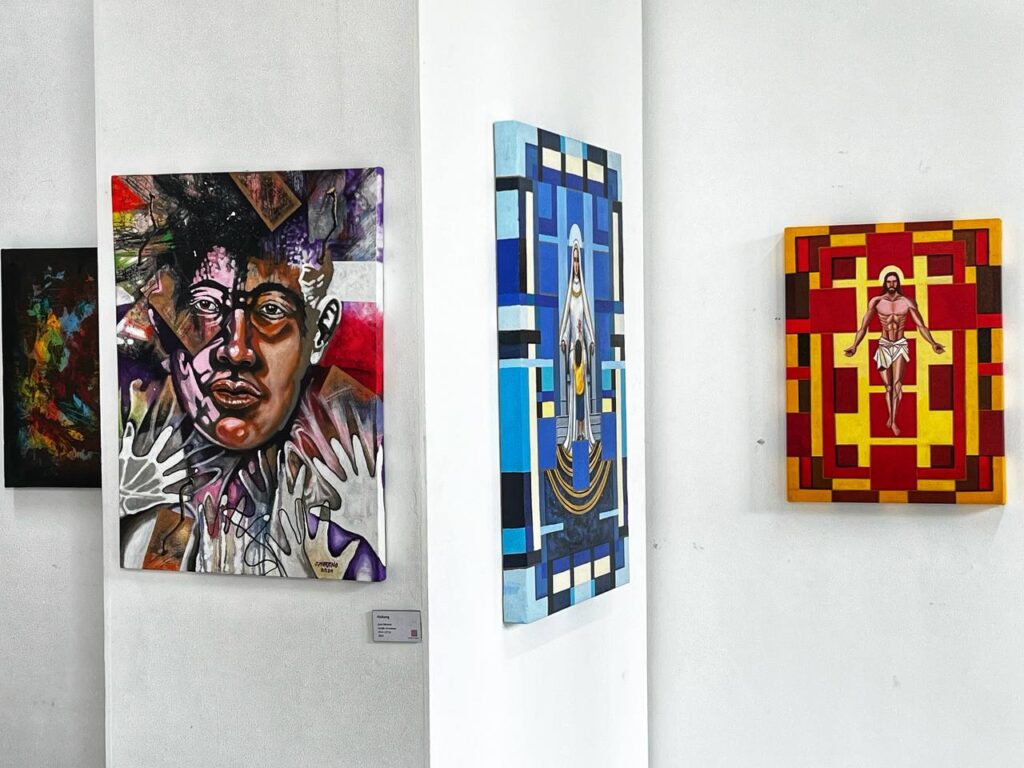Dágtà, translated to English, may refer to a stain, a blot, or anything that taints. In its verb form, it may be understood as the act of blemishing or painting a certain object or material. Construed through an artistic lens, it evokes the use of paint or any coloring material intended to emphasize, or perhaps, to contrast themes and subjects through variations of color, hue, tint, or shade. Regardless of either positive or negative connotations, the act of tainting or staining presupposes an interplay of contrasts and emphases, that some images are given the gaudy treatment of a colorful limelight while others are covered and drowned in shadow.
This reference was not lost to the Baysulangpu Artists Society’s new exhibit at Thrive Art Gallery. Aptly entitled ‘Dagta-an’, the lean collection of art by young local painters attempts to offer new visual fare to the Ilonggo audience; while their themes may be archetypally familiar, they nonetheless infuse new flavors to their homely subjects albeit in a profusion of chromatic combinations and thought-provoking iterations, as befits the title of the exhibit.

Not that this is something new for the artistic group. Baysulangpu – a clever anagram on ‘pulang subay’ (red ants) – has been around since 2001; their artists have been projecting scenes from the varied spectra of our social strata on their canvases since then. Evoking the sensation of the red ants’ agonizing bite and their communal tendencies, art becomes an instrument to sound the clarion call of advocacy for these artists.
I first encountered the art group and their advocacies back in 2022 when I interviewed two of their rising artists, Dea Mikaela Bañas and Vivien Gardose. What was meant for a profile article of two fledgling feminist painters, intended for the first issue of the Iloilo Art Review, revealed so much more about their context and their worldview that goes against the currents of the conventional art scene. Tear down the classic confines and barriers, if possible – Art for the Baysulangpu must be palpably experienced by the society that surrounds it. True to the principle behind the group’s anagrammatic moniker, good art bites its viewers to social awareness: in local parlance, dapat gapangútut.
While it is too premature to say that ‘Dagta-an’ is the group’s coming-of-age pièce de resistance, the exhibit nonetheless breaks new ground for the group. One might say that it is an updating the group’s classic coming to terms with social realities, even while experimenting with new methods or lenses of art. Featuring the artworks of Arnold Almacen, Dea Mikaela Bañas, Edmar Colmo, Edwin De los Reyes, Johanz Mercurio, June Moreno, Kimpoy Dela Cruz, Onofre Ballescos, Vivien Gardose, and Yanni Ysabel, the exhibit constitutes a young and motley collection, offering a diverse selection where hue and variety seem to anchor themes and subjects that are more introspective in nature.
Faces in phases
Central to the exhibit is the human visage in various distortions or fragmentations. Then again, the projection of the persona through portraiture has been a staple theme among artists, and many a critic has elaborated over the meanings of the furrows and greaves that line portraits and close-up shots.
For instance, senior artist Edmar Colmo’s superimposed faces propose a plurality of personalities even as these are rendered in reticent hues of grays: recurringly sundry yet also dismally repressed. And as if to comment philosophically on this Jekyll-and-Hyde duality of the human persona, June Moreno and Edwin De los Reyes’s portraits splattered with vibrant colors exude the depth and profundity which defines our Being, evocative perhaps of a less saccharine poster by Warhol.
A far cry from her mixed media attempts in early artworks, Vivien Gardose’s clusters of impressionist faces seem to garble the division between the conscious and the repressed, manifesting this internal clash in the trailing drips and sharply restrained splashes of color set on dark backgrounds. In stark contrast to these contorted visages are Dea Mikaela Bañas’s trademark astronauts, still hovering through canvases in brilliant colors and settings, still devoid of identities or temperaments; since the viewer is prevented from gazing at the figures’ eyes, there is no construing of their facial expressions, those that could have reflected the artist’s psyche onto the canvas.
Deviating from this plethora of faces though maintaining the existential introspection within the frame are Onofre Ballescos’s abstract appliques: pieces of cloth and sundry material sewn and stitched to create random patterns and configurations, exuding a certain pensive attachment for one who spectates life. The irregularity of shapes, shades, and stitches contributes haphazard and unpredictable nuances – as if the cloth and thread attempt to mend the brokenness of life itself.

Of forms and beings
Was there a subject more exploited in art than the human figure?
For one, Yanni Ysabel seems to have transcended from her demure depictions of human flesh to the flagrant portrayal of a nude female torso, languid and painted in flaming hues: reclined and relaxed, her flaming eyes sear through the viewer, even as a small though prominent cross hangs by her neck between her naked breasts; her fingers are raised in gestures that hint on a benediction – if one may conservatively describe it that way. The figure’s nudity and the juxtaposition with religious imagery are provocative: in a predominantly patriarchal society laced with religious fervor, how does one breach and jar the established norms and mores corseted by an entrenched machismo?
Conversely, the warping and abstraction of both Kimpoy Dela Cruz and Arnold Almacen’s nudes – with the flamboyant stabs and daubs of colors permeating these – further heighten rather than diminish the humanity and femininity of the nameless personas. Textured and opaque yet chromatically nebulous to the point of distortion, their artworks become visual commentaries, with wistful nods to poetry: truly, what a piece of work is man and on a more feminist note, what indeed makes a phenomenal woman?
On a more religious side, Johanz Mercurio’s cubist settings of Christ and the Virgin Mary evoke a clash of modernist precedence: Mondrian’s compositions providing a backdrop for Dali’s belated aesthetic piety. The Latin titles of the artwork endow his portraits (dare we call them that?) with a certain catholicity that is almost poetic: fiat and summum bonum were utterances, after all, from scripture and poetry. Altogether, one is tempted to attach the word ‘derivative’ as an apt modifier, but there is also an honest religiosity embedded in the sinuous geometry and the sharp contrasts employed that fascinatingly melds the minimalist with the representational. Pun intended, there is a mercurial quality to his artwork.
That Mercurio’s canvases and the aforementioned nudes were adjacently positioned did not escape the audience. Reviewer Mariela Oladive observes that this “opens a compelling exploration of the irony surrounding the female form—its duality as both sacred and taboo… this reverence [for the female body] is reflected in the idealization and celebration of the female form. Yet, paradoxically, it is also subject to societal restrictions and moral judgments, often leading to objectification or censorship.”
In this same light, this paradox of images lets surface the patriarchal structures that overlay religious undercurrents prevalent to local perceptions. The juxtaposition of a conservatively religious view of women as ‘stained’ creatures with a liberal perspective redolent of radical feminism sharply invites the viewer to question a machismo-laced religiosity. Seen in this shared space of contested ideologies, Oladive easily frames the curation in an Althusserian reading, pointing out established faiths as an ideological state apparatus that influences and shapes our moral and ethical sensibilities and biases in relation to the human corpus, particularly that of the female form.

* * * * *
If the intention of the exhibit was to present the discerning audience with fresh perspectives with which to view the world through rose-colored glasses, then it was a promising start. Perhaps, the artworks contain more of the personalities of the artists rather than the social realities that Baysulangpu was renowned for, but where does the understanding of the Other begin if not with the Self?
Consider ‘Dagta-an’ as a Rorschach test of aesthetic sensibilities: ‘tainted’ with visual assertations that may be construed as too intimate, the canvases nonetheless provoke us with new ways of seeing and thinking. Then again, is this not the function of Art?
[A condensed version of this article was originally published in Daily Guardian.]
References:
Oladive, M.A. (2024, August 14). Baysulangpu artists present ‘Dagta-an’ at Thrive Gallery. Daily Guardian. https://dailyguardian.com.ph/baysulangpu-artists-present-dagta-an-at-thrive-
gallery/
Yap, T. (2021, May 21). Baysulangpu artists reemerge in Iloilo. Manila Bulletin. https://mb.com.ph/2021/05/21/baysulangpu-artists-reemerge-in-iloilo/
